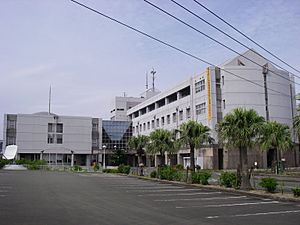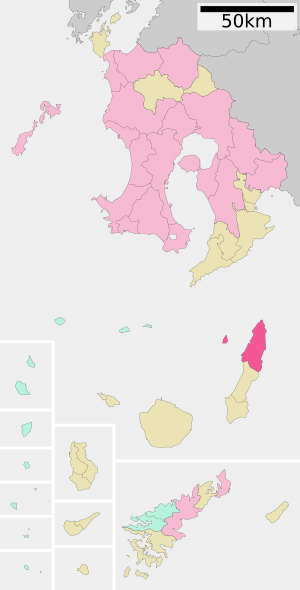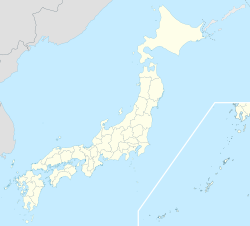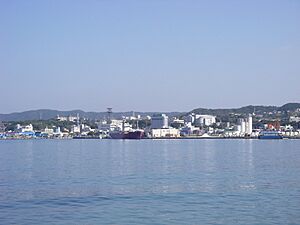Nishinoomote, Kagoshima facts for kids
Quick facts for kids
Nishinoomote
西之表市
|
|||||||||||||
|---|---|---|---|---|---|---|---|---|---|---|---|---|---|

Nishinoomote City Hall
|
|||||||||||||
|
|||||||||||||
 |
|||||||||||||
| Country | Japan | ||||||||||||
| Region | Kyushu (Ōsumi Islands) | ||||||||||||
| Prefecture | Kagoshima | ||||||||||||
| Area | |||||||||||||
| • Total | 205.57 km2 (79.37 sq mi) | ||||||||||||
| Population
(April 30, 2024)
|
|||||||||||||
| • Total | 14,151 | ||||||||||||
| • Density | 68.838/km2 (178.289/sq mi) | ||||||||||||
| Time zone | UTC+9 (Japan Standard Time) | ||||||||||||
| Phone number | 0997-22-1111 | ||||||||||||
| Address | 7612 Nishinoomote, Nishinoomote-shi, Kagoshima-ken 891-3193 | ||||||||||||
|
|||||||||||||
Nishinoomote (西之表市, Nishinoomote-shi) is a city in Japan. It is located on Tanegashima island. This island is part of Kagoshima Prefecture. As of April 2024, about 14,151 people live here. The city covers an area of about 205.57 square kilometers.
Contents
Geography and Location
Nishinoomote is found on the northern part of Tanegashima island. To its west is the East China Sea. To its east is the Pacific Ocean. The Ōsumi Strait separates Tanegashima from the main island of Kyushu. The small island of Mageshima is also part of Nishinoomote city.
Neighboring Towns
Nishinoomote shares a border with one other town:
- Nakatane
Climate and Weather
Nishinoomote has a humid subtropical climate. This means it has warm summers and cool winters. It usually does not snow here. The average temperature each year is 20.0 °C. September is the wettest month, with about 2174 mm of rain per year. August is the warmest month, averaging 27.7 °C. January is the coolest, at about 12.0 °C. The area often experiences strong storms called typhoons.
Population Changes Over Time
The number of people living in Nishinoomote has changed over many years. Here is how the population has looked according to Japanese records:
| Historical population | ||
|---|---|---|
| Year | Pop. | ±% |
| 1920 | 18,154 | — |
| 1930 | 20,533 | +13.1% |
| 1940 | 21,804 | +6.2% |
| 1950 | 30,123 | +38.2% |
| 1960 | 32,645 | +8.4% |
| 1970 | 26,222 | −19.7% |
| 1980 | 23,537 | −10.2% |
| 1990 | 20,952 | −11.0% |
| 2000 | 18,866 | −10.0% |
| 2010 | 16,951 | −10.2% |
| 2020 | 14,708 | −13.2% |
History of Nishinoomote
The land where Nishinoomote is today was once part of an old area called Tane Province. This province was removed in 824. It then became part of Ōsumi Province. Later, in 1140, Tanegashima became part of a large landholding called Shimazu shōen.
During the Edo Period (a time in Japanese history from 1603 to 1868), this area was controlled by the Satsuma Domain. Sugarcane, a plant used to make sugar, was first grown here in 1824.
Kitatane Village was officially created on April 1, 1889. This was when Japan set up its modern local government system. On April 1, 1926, it became a town and was renamed Nishinoomote.
Towards the end of World War II in 1945, about 12,000 soldiers from the Imperial Japanese Army were stationed in the town. Because of this, the United States Navy bombed the town. Nishinoomote officially became a city on October 1, 1958.
Economy and Jobs
The main ways people make a living in Nishinoomote are through farming, raising animals, and fishing. Farmers grow crops like sugarcane and sweet potatoes. People also raise animals such as cattle and pigs. Fishing is also a very important part of the local economy.
Schools and Learning
Nishinoomote has ten public elementary schools. It also has one public junior high school. These schools are run by the city government. There is also one public high school, which is managed by the Kagoshima Prefectural Board of Education.
Getting Around: Transportation
Nishinoomote Port
Nishinoomote Port is a very important place for travel. Many ferries leave from here. They go to cities like Kagoshima, Tokyo, Kobe, and Osaka. Ferries also travel to Okinawa and other nearby islands.
Major Road
 National Route 58
National Route 58
Friendship Cities
Nishinoomote has special friendship agreements with other cities. These are called "sister cities."
 Isa, Kagoshima, Japan (since November 10, 1962)
Isa, Kagoshima, Japan (since November 10, 1962) Sakai, Osaka, Japan (since October 18, 1986)
Sakai, Osaka, Japan (since October 18, 1986) Nagahama, Shiga, Japan (since October 8, 1987)
Nagahama, Shiga, Japan (since October 8, 1987) Vila do Bispo, Portugal (since October 1, 1993). This friendship is special because a Portuguese explorer named Fernão Mendes Pinto was thought to be the first European to arrive in Japan. He landed on Tanegashima in 1543.
Vila do Bispo, Portugal (since October 1, 1993). This friendship is special because a Portuguese explorer named Fernão Mendes Pinto was thought to be the first European to arrive in Japan. He landed on Tanegashima in 1543.
See also

- In Spanish: Nishinoomote para niños





